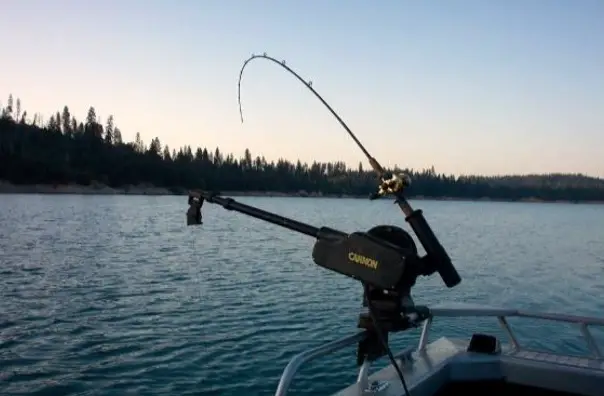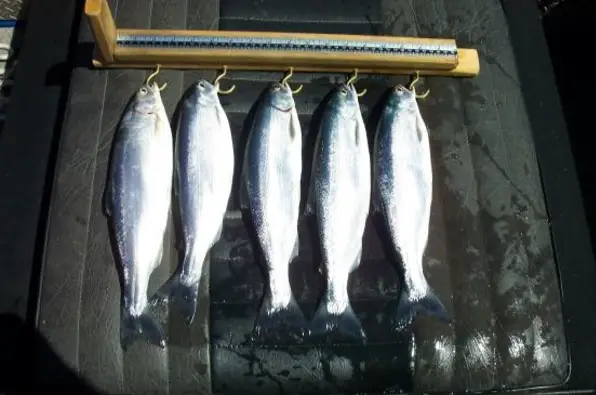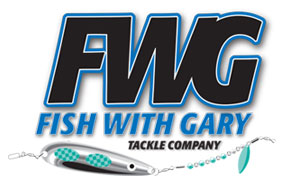Ten Common Mistakes When Pursuing Kokanee
by
Gary Gordon, March 09, 2019
A Kokanee University Mini-Series, Part 1
Before you know it, and basically in the nick of time, spring kokanee fishing will be here. Now is the time to start girting the mental game together for a great season. I put together what I consider to be the 10 most common mistakes and necessary correction factors to get right when pursuing our beloved kokanee.
1. Using the wrong gear. The ideal setup is an ultralight rod of 7 to 8 feet. The rod must be what is termed a light to medium light action. This ensures that the power (loading) of the rod is distributed evenly throughout the rod. This flexibility is mandated to properly handle the fight of the fish. You want as many guides as possible on the rod to distribute this loading. The rod must be fiberglass or a fiberglass combo. A graphite rod will soon likely snap when being used in a downrigger.
You need a bait casting reel with a reliable smooth drag that you can adjust in tiny increments. Do not use a spinning reel as trolling with it will tend to twist the line. Use 8# test monofilament fishing line. This complements the flexibility of the rod. Do not use braided line, as it has no flexibility. There is no need to use fluorocarbon, as kokanee are not line-shy. Above all, do not use lead core.
Use a downrigger to get to the proper fishing depth. And use a reliable downrigger release clip. Introducing a lead component into your fishing line in any way significantly decreases your efficiency. By efficiency I mean the percentage of success getting the fish into the boat. Lead line or lead on a sliding swivel or in-line lead takes away from your control of the rod’s flexibility – even if you use a snubber. Using any lead between the fish’s mouth and your net also makes hitting your target depth a guess. If you are using in-line lead, reaching your target depth is a formula of weight, speed and how much line is out. Most of the time an approximate guess is simply not good enough – although it can make for an undisturbed boat ride.
Be familiar with your electronics. Most have bells and whistles that some evil genius invented. Frankly, it needs to be a color fishfinder because kokanee have an air bladder. Because sonar does not penetrate air, that signal is reflected back to the sender (transducer) and then your monitor, allowing you to identify a school of kokanee. Target the bottom third of that school.
2. Drag on the reel set too tight. Proper drag for any size kokanee fight is to have the drag set just barely tight enough so that line is not coming off the reel when trolling. Once you have that set, do not adjust the drag, even if the fish is taking line. Your rod will supply the necessary pressure on the fish as long as you maintain tension. If the fish is taking line, congrats – you have a nice fish.
3. Lure too far behind attracting dodger. Kokanee are attracted to vibration and to movement. They have a significant amount of their biology devoted to the detection of sound - such as is is made by the dodger moving through water. Color makes no sound. Fish are not equipped to see color unless it is right in front of their snoots at a maximum of about 20 inches. But they can detect movement over a significant distance. For squids (hoochies), beaded spinners, bugs, and needlefish, 6 to 8 inches behind the attracting dodger is maximum distance. Being close in gives better action to the lure. The lure loses action the farther away it is from the dodger. And it is vital that the fish associate the lure with the dodger producing the attraction that brought the fish to it in the first place.
4. Trolling too slow and steady. The proper trolling speed is the speed the kokanee will strike the lure. Although it is commonly thought that 1.2 MPH is THE proper speed, that is simply false. The 1.2 MPH speed was ingrained in the early days of the kokanee sport because of the equipment being used. One could not troll the giant sets of flashers any faster than that without tangling up the flashers and fishing line. But we now play in the age of ultralight gear, and the 1.2 MPH limitation does not apply. Most successful kokanee fishermen troll at about 1.8 MPH. Kokanee can swim way faster than that. A cruising kokanee will swim at about 0.7 MPH to about 2.0 MPH. A higher trolling speed sparks a more aggressive bite because that gives more action to the dodger and, hence, to the lure following it.
More action can be obtained by varying the speed of presentation. But you need not be constantly speeding up and slowing down the trolling motor to accomplish this. Varied speed can be accomplished with simply trolling in a long “S” curve. It is the speed of your lure and not the speed of the boat that counts. As you troll forward into your long “S” turns, the outside lure will speed up and rise, while the inside lure will slow down and lower. The long “S” turn will alternate which lure is coming up and going faster and which lure is slowing down and sinking. The net effect is to give you a range of speeds and vertical distance in the water column, thereby significantly increasing your chances of a hookup.
5. Not enough scent. Salmon are extremely capable of detecting scent, even in scent distribution over great distance. The right scent is a bite stimulant. I strongly recommend the use of commercial scents available these days. The more scent the better. I used to think that loading up scented corn on the hooks was the best way to go, and, yes, it caught fish. But then I noticed that the corn weighed more than the lure; and, at lower speeds, the cone weighed down the lure so much it stopped the lure’s action. I now practice just putting gel scent on the beads or on the body, and on squids I use a liquid scent – with some gel inside the bell of the squid. Never put scent on the spinner or on the dodger. I no longer use corn. By putting the scent just ahead of the hooks, the fish will concentrate on the scent, and the so-called “short bite” is practically eliminated. And by not using corn, you will never have to worry about whether the corn is still on the hooks.
6. Not keeping your hands “fish worthy.” We all know that things such as deodorant, sunscreen, bananas, and other strongly scented things will repel a fish. When I am ready to put my setup together on the boat, the first thing I do is squirt some liquid anise on my hands and rub it in like hand lotion. And handling the fish after being caught is also an excellent way to retain the proper non-offending scent. And, above all, tobacco is a fish repellent.
7. Not using a rubber net. A regular cloth net will easily catch and retain the hooks after you have used it to land your fish. Unless the fish is instantly restrained, it will flop about and break off one or both hooks. This is pretty much guaranteed if you land a double in a cloth net. This will not happen with a rubber net.
8. Not reacting to the hookup fast enough. About 25% of the time (depending on which part of the season you are in) your kokanee with hook itself so violently that the second hook will lodge somewhere in the bony snoot of the fish. When this happens, even the very worst technique will likely get the fish inside the boat. That leaves the fact that about 75% of the time the fisherman must play an active role in getting the fish inside the boat.
Whatever you do, do NOT do anything that “sets the hook.” When the downrigger release clip trips, the rod tip will be free to move. The forward speed of the boat and the flexibility of your ultralight rod is all that is needed to “set the hook.” The fish will be darting in an unpredictable direction and at speed. It is imperative that you take up the slack quickly just to the point where you can regain that light tension on the line. With some take downs, the fish will swim directly toward the boat, and you may think the fish got off when it has not. When fishing at depth, the fish will often speed toward the surface, creating a “U” shaped curve in your line. In all situations take up that slack immediately. Failure to do so will cause that dreaded “long distance release.”
9. Not keeping colors of dodger and lure consistent. As stated above, color does not create any attracting vibration. The movement of the dodger through the water makes more intense “noise” than does the lure. Matching dodger and lure colors has become the norm in the past ten years after I strongly advocated for that in my Kokanee University, Part 1. You can go to my website at
Fish With Gary Tackle Co. for a more detailed discussion. Suffice it to say, it has a lot to do with positive imprinting. Since color produces no vibration, color must be a bite stimulant. And color to the eye of a kokanee is only available up close. The majority of the color is going to be on the dodger simply due to its size. Scent on the lure is the other bite stimulant. Color and scent do work together. Maximize the color stimulant by making the dodger and lure colors consistent.
10. Not using the downrigger in shallow water. In my home reservoirs, early season means setting my downriggers at 3 feet. I am fishing shallow (it is a water temperature issue), because the flats will be not fishable later when the reservoir water level is lowered for irrigation needs. Happily, early season kokanee love the flats when they can get to it. But with shallow water come obstacles such as stumps that only appear when you have just passed over them. If I were long-lining, I would be more challenged in keeping my setup above the obstacles.
I use the “Rule of 100” when setting out the presentation. I take the target depth number and add it to the setback number so that both add up to 100. If my target depth is 10 feet, my setback is 90 feet. If my target depth is 80 feet, my setback is 20 feet. Many good fisherman use their own formula, but this has worked well for me, particularly at the deeper depths. At such depths, the minimum setback is a real help in taking up slack when the hooked kokanee is blasting toward the surface.
Next: Great advice for taking advantage of the unique kokanee temperament.
Gary S. Gordon, owner
Fish With Gary Tackle Co. © 2109 Gary S. Gordon
Comments
Why is this comment inappropriate?
Delete this comment? Provide reason.




